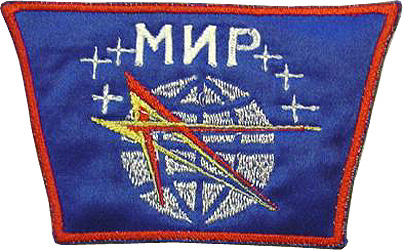
February 5 - December 29, 1987
(Laveikin & Spacecraft: July 30, 1987)
|
|

February 5 - December 29, 1987
(Laveikin & Spacecraft: July 30, 1987)
| Crew & Mission |
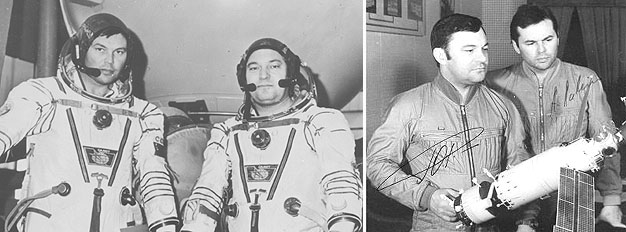
Soyuz TM-2 was the first manned version of the Soyuz-TM-spacecraft, specially designed for flights to the Mir station. Soyuz TM-2 was launched on February 5, 1987 with cosmonauts Yuri Romanenko and Aleksandr Laveikin (callsign "Tamyr"). Their spaceship docked to the front of the Mir/Progress-27 complex two days later. (Progress-27 had arrived on January 18, 1987). With TM-2 safely arrived, the orbit of the entire station was lifted by the Progress' engines on February 11. Progress-27 undocked on February 23 and was replaced on March 5, 1987, by Progress-28, which was launched two days earlier. After the cosmonauts had unloaded the freighter, it left Mir on March 26.
The room left by Progress-28 was to be filled by the first research module: Kvant-1. It was launched on March 30 and performed two major course corrections on April 2 and 5. With Romanenko and Laveikin safely retracted into the Soyuz TM-2 capsule, the Kvant lost track of Mir some 400 meters before the planned docking and missed the complex by 10 meters. A second attempt on April 9 went better, but this time the new module had problems hard-docking to the aft port of Mir.
During a 3 hour and 40 minute spacewalk, performed on April 11, Romanenko and Laveikin found a cloth bag jammed in the Mir-docking module and one of them - risking his hand in between the two partially docked modules - removed it. Kvant then succesfully docked and jettisoned its service module, making room for Progress-29, which arrived at the station on April 23 and left May 11, 1987. Progress-30 arrived on May 21.
After two more spacewalks on June 12 (1 hour, 53 minutes) and June 16 (3 hours, 15 minutes) to install a solar array boom to solve recurring power shortages, doctors on the ground started to see something wrong with Laveikin's cardiovascular system. There was no immediate threat to his health, but doctors decided to bring him home as soon as possible. On July 22, a visiting crew consisting of Aleksandr Viktorenko, Aleksandr Aleksandrov and Mohmand Faris were launched to Mir aboard Soyuz TM-3. The craft docked to the aft port of Mir (vacated by Progress-30 on July 19) on July 24. Viktorenko left the station on July 30, taking Laveikin and Faris with him and leaving Aleksandrov behind.
Romanenko and Aleksandrov, continuing the EO-2/"Tamyr" mission, received the three-man Soyuz TM-4 crew on December 23, 1987. Romanenko and Aleksandrov returned to Earth with one of them, Anatoly Levchenko, on December 29. Vladimir Titov and Musa Manarov stayed onboard Mir as the third main expedition (EO-3) crew. Completing his mission, Romanenko had spent 326 days in space!
| The Real Thing |
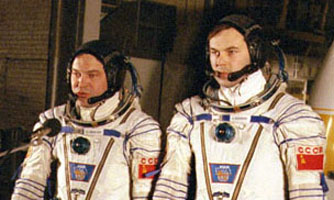
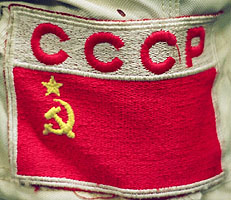
The cosmonauts of Soyuz TM-2 were launched with a new Sokol suit, which was specially designed for the TM-ship. The typical wedge-shaped Salyut patch on the front of the suits was replaced by a Mir-patch with roughly the same shape and the familiar Zvezda-design. The cosmonauts had a Soviet seal on the right sleeve and a modern type CCCP-flag (rounded letters, fully embroidered type) on the left sleeve. This marked the end of the "square lettered", felt CCCP-flag patch that was seen on many previous missions.

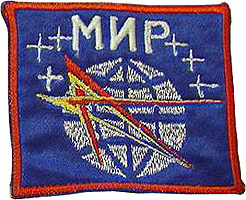
Left: Laveikin (with guitar) and Romanenko in their Penguin-suits aboard Mir. Note the 'clipped'
first generation Mir-patch, replacing the square Salyut-logo seen on previous flights.
Right: A close-up of the 'clipped' patch.
On their Penguin-suits, the cosmonauts were wearing a 'clipped' version of the same Mir patch that was on the Sokol-suits. Except for this patch, which took the place of the square Salyut logo on the lower right chest, the configuration on the Penguins was the same as the EO-1 crew: a Soviet Seal at the upper left chest and a CCCP-flag (silk, rounded letters) at the left sleeve. The square Mir patch was also stitched to the Zvezda-produced sleeping bags aboard the station.
| Mission patch? |
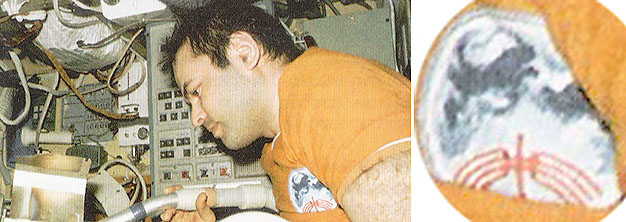
| The Orlan-DM EVA-suit |
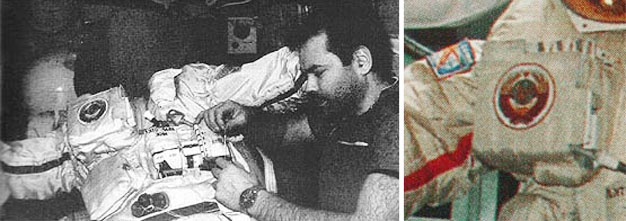
As described above, Romanenko and Laveikin made the first spacewalks outside Mir (April 11 to dock Kvant; June 12 and 16 to attach new solar arrays). Romanenko used Orlan DM-suit number 7 (red stripes) and Laveikin used DM-9 (blue stripes). Both suits had a large Soviet seal to the front of the electrical control unit and a CCCP-flag (silk type, rounded letters) to the left sleeve. Attached to the right sleeve was a Salyut square-patch.
| Collecting TM-2 |